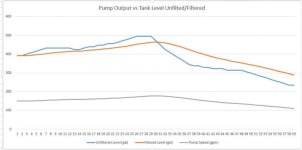TheWaterboy
Lifetime Supporting Member + Moderator
What technique would I employ when I have a tank that I am pumping out of at the same time water is flowing into it and I want to keep the flow as consistent as possible while making sure the tanks level doesn't get out of hand?
Currently I focus on the tanks level and a PID controls that quite well. A side effect due to the inconsistent inflow is that the VFD driven pump changes speed to maintain the level and the effluent flow obviously varies along with it. Sometimes quite a bit.
I would like to change this configuration so that the effluent flow remains much more consistent and the tank acts as the influent accumulator and changes to the level are permitted within a certain boundary with only a slight increase/decrease being felt as effluent flow.
I of course will need to sacrifice consistent effluent flow should the Tank level change dramatically or get to a dangerous level, but otherwise a couple feet of variance is OK if it would give me more consistent effluent flow.
What technique would I use to create this 2 input type of control? I have never created a cascade of PID's or "Feed Forward" (but have heard the words before ) so I would need to do my homework to figure out how to construct one, should one of those options, or some other, be the proper technique to use in this instance
) so I would need to do my homework to figure out how to construct one, should one of those options, or some other, be the proper technique to use in this instance
I would greatly appreciate opinions on the correct control strategy I should follow.
Currently I focus on the tanks level and a PID controls that quite well. A side effect due to the inconsistent inflow is that the VFD driven pump changes speed to maintain the level and the effluent flow obviously varies along with it. Sometimes quite a bit.
I would like to change this configuration so that the effluent flow remains much more consistent and the tank acts as the influent accumulator and changes to the level are permitted within a certain boundary with only a slight increase/decrease being felt as effluent flow.
I of course will need to sacrifice consistent effluent flow should the Tank level change dramatically or get to a dangerous level, but otherwise a couple feet of variance is OK if it would give me more consistent effluent flow.
What technique would I use to create this 2 input type of control? I have never created a cascade of PID's or "Feed Forward" (but have heard the words before
I would greatly appreciate opinions on the correct control strategy I should follow.






